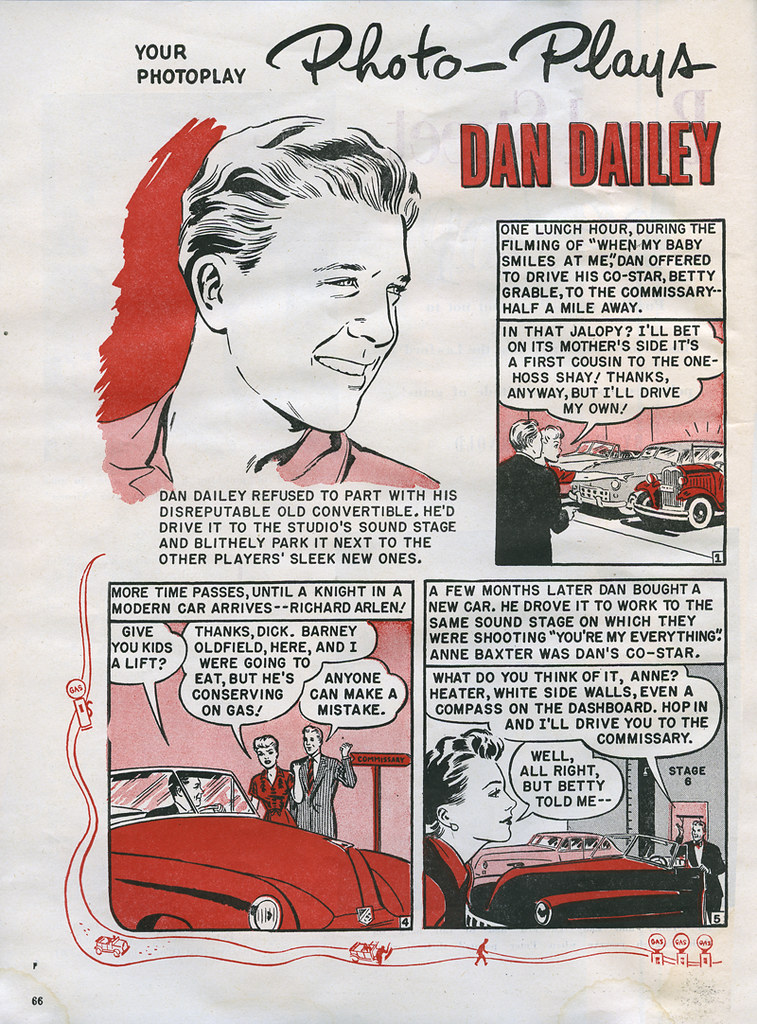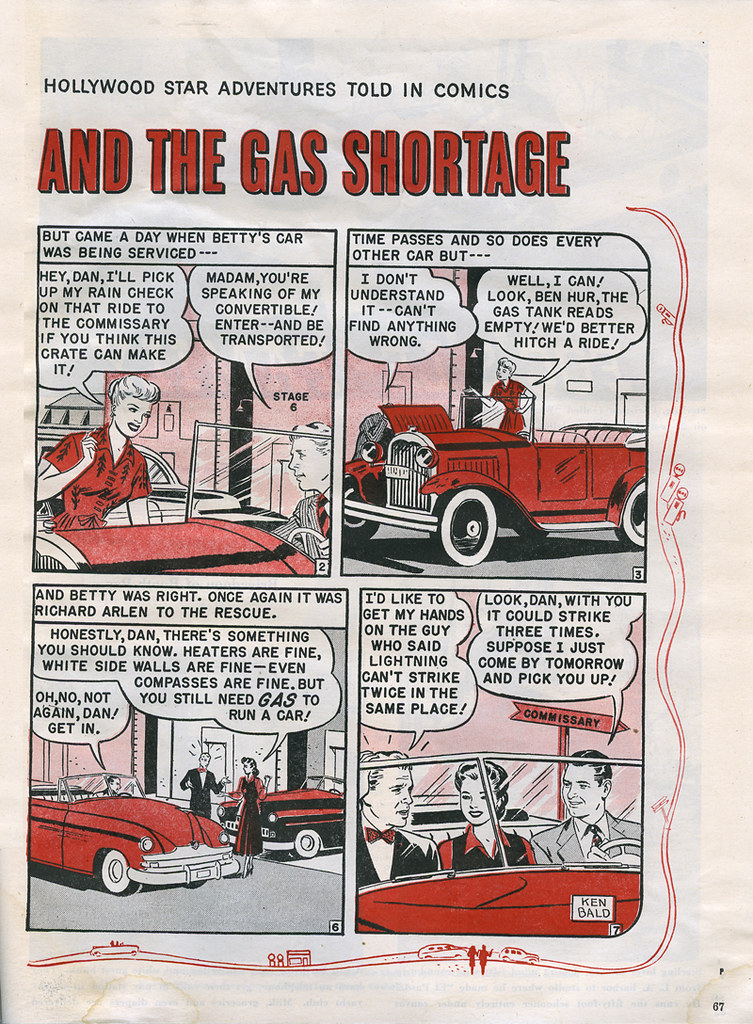In which photo-play did actor Dan Dailey, actress Anne Baxter, actress Betty Grable, and illustrator/comic book artist Ken Bald all appear together? You're looking at it. Only one of these "stars" is left, Ken Bald.
This comic appeared in the April 1949 Photoplay magazine.
Click on either image to see it larger.
Unless you're a fan of comic book art, you might not be aware of Ken Bald:
Kenneth Bruce Bald (born August 1, 1920) is an American illustrator and comic book artist best known for the Judd Saxon, Dr. Kildare and Dark Shadows newspaper comic strips. Due to contractual obligations, he is credited as "K. Bruce" on the Dark Shadows strip
Early life and career
Ken Bald was born in New York City, New York and raised in suburban Mount Vernon, New York. He attended Pratt Institute in Brooklyn for three years, then joined the Englewood, New Jersey studio of Jack Binder, one of the early comic-book "packagers" who would supply complete comics on demand for publishers entering the new medium. Beginning in 1942, during the 1940s period fans and historians call the Golden Age of Comic Books, Bald, via Binder, began drawing backup features for the prominent Fawcett Comics.
Creator credits were not routinely given during this era, and while historians have tentatively identified Bald as both penciler and inker of the 14-page Bulletman story "The Terror of the Iceberg" in Fawcett's Master Comics #26 (May 1942), his earliest confirmed credit is penciling the 16-page Captain America story "Ali Baba and His Forty Nazis" in Captain America Comics #32 (Nov. 1943), published by Marvel Comics precursor Timely Comics.
Going on staff at Timely, Bald drew stories of such superheroes as Captain America, the Sub-Mariner, the Blonde Phantom, the Destroyer, and Miss America variously through comics cover-dated July 1949. He both wrote and drew a number of Millie the Model humor stories in the comics Georgie and Patsy Walker, and at least drew the teen-humor character Cindy in Georgie and Judy Comics and Junior Miss.
Bald penciled the first appearance of the Sub-Mariner spin-off character Namora, in "The Coming of Namora" in Marvel Mystery Comics #82 (May 1947), but it is unclear if he helped create the character; the cover, which was sometimes created first, featured Namora draw by Bob Powell. Similarly, Bald drew Timely's single issue of The Witness (Sept. 1948), starring a character co-created by writer-editor Stan Lee, but the cover for which was drawn by Charles Nicholas. Bald, with an unidentified writer, co-created Timely the superhero Sun Girl, who starred in a three-issue series cover-dated August to December 1948.
His other comic-book work included the character Crime Smasher in Fawcett's Whiz Comics in the 1940s, and many anthological horror/suspense stories in American Comics Group's Adventures into the Unknown, The Clutching Hand, Forbidden Worlds and Out of the Night from 1949 through late 1954. Also for ACG, he co-created the adventure feature Time Travelers in Operation: Peril #1 (Nov. 1950)
Personal
Bald and his wife, Kaye, have five children. (SOURCE: Wikipedia)
To see more of Ken Bald's work:
His papers are archived at Syracuse University Library.














I'm currently reading the Will Eisner biography. Interesting if only for for the fact he was on the leading edge of the Comics both as serial strips in the Sunday funnies, but also developed the comic 'book' insert for Sunday newspapers, which is where the comic book was born.
ReplyDeleteDave, what's the name of the book? I never knew how comic books came about.
ReplyDelete"A Dreamer's Life in Comics" - Will Eisner by Michael Schumacher. No sensationalism, just a well-told story.
ReplyDeleteI'm sorry, but the comic book was not created as a comic "book" insert by Will Eisner. It was created by Max Gaines who, watching the bit comics sections coming of a press, thought that if they were folded once, then folded again, they'd make a magazine sized publication. He tried it, selling them on NYC newsstands, and it worked. His son went on to publish Mad Magazine, among other comic book titles. Yes, Mad started as a comic book. Michael Vance
ReplyDelete